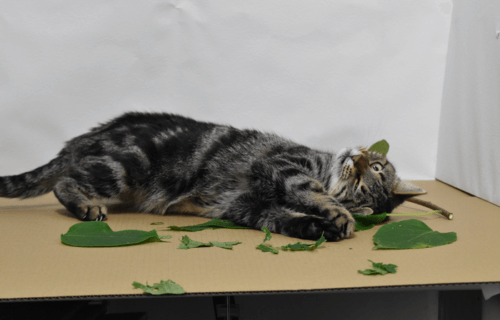MORIOKA, Japan — What is it with cats and catnip? Anyone who has ever seen a cat aggressively rub against, roll on, lick, and chew catnip knows that there is something distinctly intoxicating about the plant — and its Asian counterpart silvervine. Now, fascinating new research out of Japan suggests there may be another reason cats love catnip so much. Scientists at Iwate University have discovered that when a cat damages catnip, it releases strong insect repellents.
Putting intoxication aside for a moment, researchers believe felines may have evolved to like catnip as a way to protect themselves from pests. Lead study author Masao Miyazaki, an animal behavior researcher at Iwate University, says he wanted to unravel the mystery of cats’ unique relationship with catnip and silvervine.
“Even in the famous musical Cats there are scenes where you see a cat intoxicate another cat using catnip powder,” he says in a media release.
The leaves of both catnip and silvervine contain the nepetalactol and nepetalactone compounds, which are iridoids that serve to protect plants from pests and insects. So, the research team decided to test how a cat’s actions with catnip (like shredding, breaking, and biting) influence the chemicals released by the plants.
“We found that physical damage of silvervine by cats promoted the immediate emission of total iridoids, which was 10-fold higher than from intact leaves,” Miyazaki explains.
More iridoids were released, but that’s not all. The iridoids’ very composition appeared to change in ways that encouraged the cats.
“Nepetalactol accounts for over 90% of total iridoids in intact leaves, but this drops to about 45% in damaged leaves as other iridoids greatly increase,” Miyazaki says. “The altered iridoid mixture corresponding to damaged leaves promoted a much more prolonged response in cats.”
Catnip chemicals are an excellent mosquito repellent
Earlier research conducted by Miyazaki revealed that these compounds repel Aedes albopictus mosquitoes quite efficiently. Now, this latest work shows that when damaged by cats, the plants’ repellent properties become even stronger. For instance, the diversification of iridoids within damaged silvervine leaves repels mosquitoes more efficiently at low concentrations.
Next, to see if cats react to these compounds specifically, researchers gave a group of felines food containing pure nepetalactone and nepetalactol.
“Cats show the same response to iridoid cocktails and natural plants except for chewing,” Miyazaki notes. “They lick the chemicals on the plastic dish and rub against and roll over on the dish.”
“When iridoid cocktails were applied on the bottom of dishes that were then covered by a punctured plastic cover, cats still exhibited licking and chewing even though they couldn’t contact the chemicals directly,” he continues. “This means that licking and chewing is an instinctive behavior elicited by olfactory stimulation of iridoids.”
Moving forward, study authors want to identify the exact gene responsible for cats’ reaction to catnip and silvervine.
“Our future studies promise to answer the key remaining questions of why this response is limited to Felidae species, and why some cats don’t respond to these plants,” Miyazaki concludes.
The study is published in the journal iScience.

